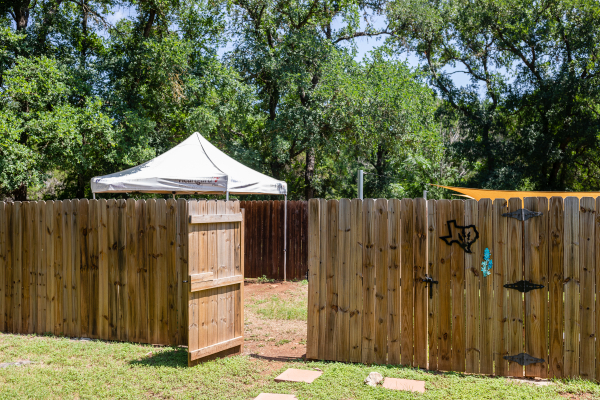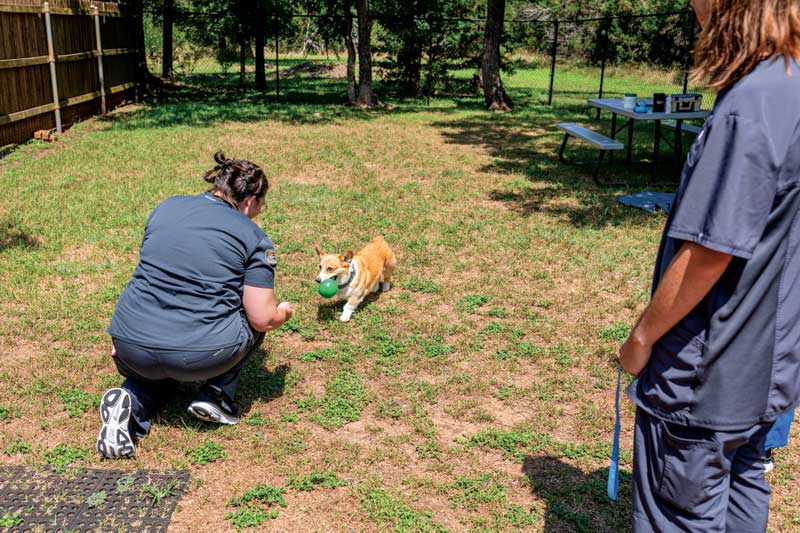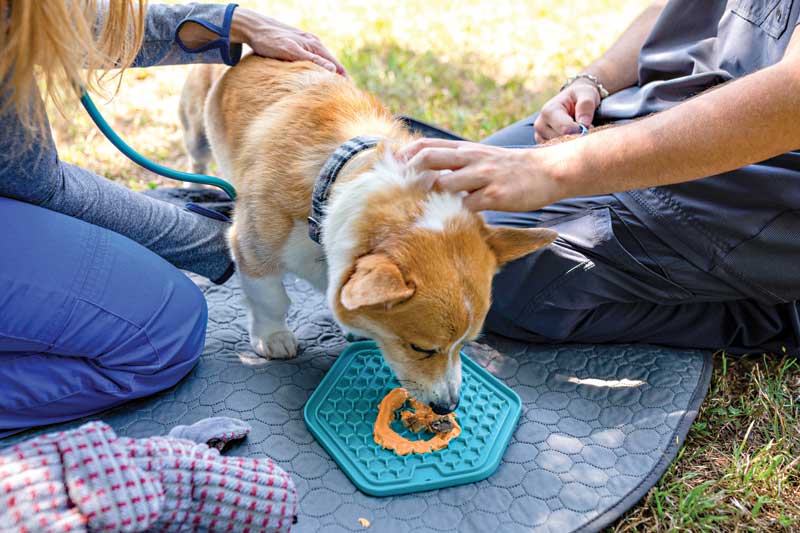
gate. Photo courtesy Dana Wile
“I have too many exam rooms,” said no veterinarian ever.
Veterinary hospitals have an average of three exams rooms.1 A practice needs two to 2.5 exam rooms per veterinarian.2 Chances are, your hospital is short one or more exam rooms. Animal Arts, a veterinary architecture firm in Boulder, Colo., agrees, “You can never have too many exam rooms!”3
Renovating to add exam rooms is a smart business decision. Each exam room averages $342,312 in annual medical revenue.4 You will spend about $130 per square foot to renovate an existing building.2 A 200-square-foot exam room will cost you about $26,000 to remodel—but where can you find the extra space?
Shrink your food room
Look at the footprint that food storage consumes at your practice. Management consultants estimate practices pay 28 percent to 40 percent of the product cost to manage the inventory.5 Food also has lower markups of 39 percent for therapeutic diets compared to 65 percent for preventives and 107 percent for prescription medications.6
Lead more clients to home delivery through your online pharmacy and pet food partnerships, which lets clients get direct shipments while revenue sharing with your practice. Auto shipment programs often include free shipping and rewards for clients.
Only stock starter cans and bags at your practice. When changing a patient’s diet, bring the product into the exam room and explain food transition instructions to the client. Say, “Here’s your starter bag. Let’s get you signed up for home delivery and place an order today. Your first auto shipment will arrive on your doorstep in three to five days. Recurring refills will arrive every four weeks so you never run out of food!”
Home delivery appeals to busy working families, seniors who struggle to carry heavy items, and millennials who order lots online. Hospitals save on inventory and free up part of the square footage for new income-generating exam rooms.
Another reason to lead clients to auto shipments: Compliance for therapeutic diets skyrockets to 10 bags per year compared to 1.8 bags sold at the hospital.7
Go outdoors
Star of Texas Veterinary Hospital in Austin, Texas, puts a southern flair on being a Fear-Free certified practice with its outdoor exam spaces on a four-acre wooded lot. Each 20 x 20-foot outdoor exam space has an eight-foot wood privacy fence, tent, picnic table, locking supply box, and locking gate. “Backyard appointments” help the four-doctor hospital promote its Fear Free methods. About 15 patients per day are seen in the three outdoor exam spaces. The hospital spent less than $2,000 on fencing, picnic tables, and supplies.

Weather is the only limitation. “When it’s 112 degrees in the summer, clients can only book 8 a.m. appointments when it’s cooler,” says Star of Texas Veterinary Hospital administrator Dana Wile, CVBL. “We move tents around as the sun moves. Clients and dogs love our outdoor exam spaces. It’s like going to the dog park for a walk.” Her only regret is not covering the tops of outdoor exam spaces. An affordable solution might be a carport canopy. Next, Wile is planning an outdoor “catio,” where cats can enjoy a fully enclosed outdoor exam space.
Drive-thru service. Marty Greer, DVM, JD, opened a small animal drive-thru wellness center, Checkout Veterinary in Sun Prairie, Wis. The hospital has four garage bays where clients can drive in and pets are isolated from other patients. Care can be delivered in garage bays or in adjacent exam rooms with Dutch doors, where clients can see their vehicles.

Reclaim part of your lobby
Reduce your waiting space. Clients will appreciate being escorted immediately into exam rooms instead of passing time in a noisy, high-traffic lobby. At Fetch Specialty and Cancer Centers in Bonita Springs, Fla., clients enjoy a comfortable and welcoming waiting porch.
Scrutinize your seating arrangement. Have small group seating areas rather than long rows of chairs that make the lobby look cluttered, advises Jeff Clark, AIA, ICC, principal of MD Architects in Indianapolis, Seattle, and Boston.8 Bench seating welcomes clients of all body types.
Use free-standing kiosks instead of traditional reception desks, Clark recommends. Untether your client service representatives (CSRs) with wireless headsets and tablets. CSRs can greet clients at the front door and escort them to exam rooms for in-room check-in. Veterinary assistants or technicians can wrap up visits with exam room checkout, reducing payment time from the seven to 10 minutes for traditional front-desk checkout. Ask your practice-management software provider about securely stored credit-card information in its platform, compatible apps for payment, and credit card terminals in exam rooms.
Phones can be answered nearby in a cubby or consider remote CSRs who answer phones and schedule appointments from home.
Repurpose retail space. Run a sales report of your annual retail revenue. Convert the space into one or more exam rooms. Shift sales of collars, leashes, and retail products to your online pharmacy.
Reconfigure doctors’ offices
Forgo traditional doctors’ offices that practices had in 1985. Veterinarians can have private spaces for calls and recordkeeping, but money-making exam rooms take priority. Animal Arts suggests having a shared glass fishbowl workstation adjacent to the treatment area, which is an efficient use of space and controls noise. Build one or two phone booths for additional privacy where doctors and support staff can participate in Zoom meetings and webinars or conduct telehealth visits. A large, shared doctors’ office now becomes smaller work cubbies, and you get the extra exam rooms or dental suite you have been dreaming of.
Ideally, exam rooms should measure at least 10 x 10 feet to allow space for medical staff, patients, and clients.9 Exam spaces do not require much storage. Mobile carts can contain supplies, make restocking easier, and be tucked away when not in use.
Think creatively. Where could you find 10 x 10-foot space—inside or outside? Reward yourself with a new exam room that can be used for doctor and technician appointments as well as a multi-purpose room for consultations, euthanasia, and other medical services.
Wendy S. Myers, CVJ, has taught communication and client service skills for more than two decades. As founder of Communication Solutions for Veterinarians, she teaches practical skills through online courses, onsite coaching, and conferences. Myers was a partner in a specialty and emergency practice. Visit YouTube.com/csvets and CsvetsCourses.com for more.
References
- Mattson K. A Blueprint for Veterinary Spaces. JAVMA News. Available at: https://www.avma.org/javma-news/2021-04-15/blueprint-veterinary-spaces. Accessed Dec. 7, 2023.
- Hoeksema A. Opening a Profitable Vet Clinic: Numbers You Need to Know. ProjectionHub. Available at: https://www.projectionhub.com/post/opening-a-profitable-vet-clinic-numbers-you-need-to-know. Accessed Dec. 8, 2023.
- The ABCs of Veterinary Hospital Design. Animal Arts. Available at: https://www.animalarts.com/the-abcs-of-veterinary-hospital-design/. Accessed Dec. 8, 2023.
- Hawn R. Hospital Considerations: Expand or Build New? AmerisourceBergen. Available at: https://www.mwiah.com/our-insights/hospital-considerations. Accessed Dec. 8, 2023.
- Brown J. Deliver the Goods. Today’s Veterinary Business. Available at: https://todaysveterinarybusiness.com/deliver-the-goods/. Accessed Dec. 8, 2023.
- AAHA Veterinary Fee Reference. AAHA Press 2020: 229, 228.
- Garrison G. No Place Like Home (Delivery). VetAdvantage. Available at: https://vet-advantage.com/vet_advantage/no-place-like-home-delivery/. Accessed Dec. 8, 2023.
- The Power of First Impressions at the Vet. MD Architects. Available at: https://www.mdarchitects.com/the-power-of-first-impressions-at-the-vet. Accessed Dec. 8, 2023.
- Animal Hospital Design Strategies for Better Care. AAHA. Available at: https://northamerica.covetrus.com/docs/default-source/landing-pages/equipment-new-build/midmarkhospitaldesignstrategies_small.pdf?sfvrsn=40b16d73_2. Accessed Dec. 8, 2023.
